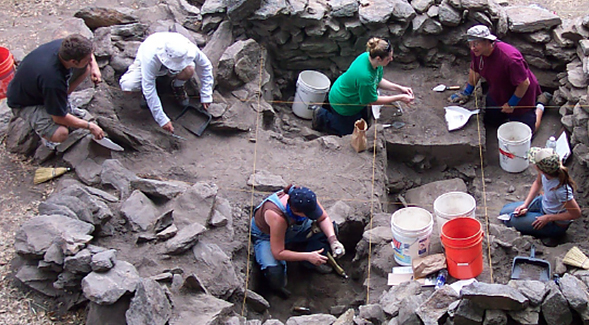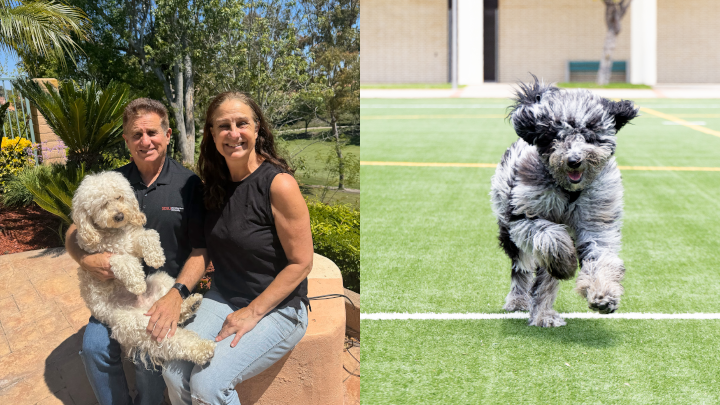Artifacts of San Diego Black Pioneers Life on Display in Exhibit
Archaeologist Seth Mallios and hundreds of students have spent more than 15 years excavating the Palomar Mountain cabin site.

“There is far more going on at this site than initially meets the eye; Harrison was a local icon and a nexus for exchange.”
A rifle powder flask, a pocket watch and sock garters from the Palomar Mountain cabin site of San Diego’s first African American homesteader are among more than 100 artifacts recovered by a San Diego State University anthropologist and his students, newly unveiled in a public exhibit.
Seth Mallios has led archaeological excavations at freed slave Nathan “Nate” Harrison’s original hillside homestead since 2004. The San Diego History Center exhibit, which opens Mar. 18 in a virtual format, is drawn from more than 50,000 artifacts uncovered by students in his field schools.
Via Zoom, Mallios and his co-curators — graduate students Shannon Farnsworth and Jamie Bastide — will walk participants through the exhibit using augmented reality to share their first-hand knowledge of the dig, artifacts, and history. The exhibit includes an 11x11-foot replica of Harrison’s cabin.
Mallios is the author of “Born a Slave, Died a Pioneer: Nathan Harrison and the Historical Archaeology of Legend” (2020, Berghahn Books). The book explores Harrison’s life and the finds made in years of excavation at the site he made a permanent residence after surviving the horrors of slavery in the antebellum South and enduring the mania of the California Gold Rush.
In venturing outside San Diego archaeological sites, Mallios said, “I wanted to do something new and different. I started researching Nathan Harrison and found later that the readily available information was full of inaccuracies.”
Surprising findings
More than 100 SDSU students have excavated the site over the years, and some have gone on to become professional archaeologists.
“A student found a rifle powder flask dating to the Civil War. I’ve never seen anything like it in California — it’s made of zinc and tin,” Mallios said. “It’s spectacular. I’ve seen similar items from digs in Pennsylvania and Virginia, but none out West.”
The item, like the hundreds of fired rifle cartridges found at the site, is notable not only for its antiquity, but also because it was explicitly illegal in California during this time for people like Harrison to sell firearms and munitions to those consorting with the local Indigenous population. The archaeology revealed much about Harrison’s secret double life, which he was forced to conceal during the severe racial tensions of the late 19th and early 20th centuries.
Said Mallios: “The site originally looked like a traditional rural assemblage, but then certain high-status items started to appear. We found an 1898 silver quarter and many other coins, as well as a pocket watch, a decorative Meerschaum pipe, ‘Presidential’ brand suspender clips, and fancy nickel-plated sock garters from the early 1900s. There is far more going on at this site than initially meets the eye; Harrison was a local icon and a nexus for exchange.”
Doing fieldwork proved inspirational for Shannon Farnsworth. After receiving her bachelor’s degree in anthropology and history, she decided to join the master’s program in anthropology, ensuring that she could continue working on the project.
Farnsworth said, “The most interesting thing about the dig was the amount of independence we were given. Of course, we were trained and supervised, but the ability to take a trowel and dig in an archaeological unit myself was a dream come true. I grew up playing Tomb Raider and always wanted to uncover things, but I never thought I would be given the opportunity to actually find things that are more than 100 years old in the ground.”
In-person features
Located in Balboa Park, the History Center exhibit is scheduled to be open for a year with the hope that visitors will have an opportunity to attend in-person. At that time, a projector housed in the ceiling at the museum will provide augmented reality to help visitors feel as though they are digging in the dirt alongside the research archaeologists.
For exhibit viewers, Mallios said, “This is a story of amazing perseverance — there aren’t too many examples in which someone overcomes so many obstacles and hardships. When you think about life, liberty and the pursuit of happiness, somehow Nathan Harrison was able to attain these ideals despite being at such a tremendous disadvantage.”
Harrison lived when slaves were freed, a time Mallios said “should have been the most empowering time, and yet more people were lynched after the Civil War than before. The Post-Emancipation period was supposed to be a time of opportunity (for former slaves), yet it was not.”
Registration is now open for the virtual exhibition opening event at 5 p.m. on Mar. 18.



